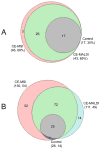Pressure-assisted capillary electrophoresis coupling with matrix-assisted laser desorption/ionization-mass spectrometric imaging for quantitative analysis of complex peptide mixtures
- PMID: 22891936
- PMCID: PMC3445710
- DOI: 10.1021/ac300628s
Pressure-assisted capillary electrophoresis coupling with matrix-assisted laser desorption/ionization-mass spectrometric imaging for quantitative analysis of complex peptide mixtures
Abstract
Herein, we report a pressure-assisted capillary electrophoresis-mass spectrometric imaging (PACE-MSI) platform for peptide analysis. This new platform has addressed the sample diffusion and peak splitting problems that appeared in our previous groove design, and it enables homogeneous deposition of the CE trace for high-throughput MALDI imaging. In the coupling of CE to MSI, individual peaks (m/z) can be visualized as discrete colored image regions and extracted from the MS imaging data, thus eliminating issues with peak overlapping and reducing reliance on an ultrahigh mass resolution mass spectrometer. Through a PACE separation, 46 tryptic peptides from bovine serum albumin and 150 putative neuropeptides from the pericardial organs of a model organism blue crab Callinectes sapidus were detected from the MALDI MS imaging traces, enabling a 4- to 6-fold increase of peptide coverage as compared with direct MALDI MS analysis. For the first time, quantitation with high accuracy was obtained using PACE-MSI for both digested tryptic peptides and endogenous neuropeptides from complex biological samples in combination with isotopic formaldehyde labeling. Although MSI is typically employed in tissue imaging, we show in this report that it offers a unique tool for quantitative analysis of complex trace-level analytes with CE separation. These results demonstrate a great potential of the PACE-MSI platform for enhanced quantitative proteomics and neuropeptidomics.
Figures





Similar articles
-
Semi-automated liquid chromatography-mass spectrometric imaging platform for enhanced detection and improved data analysis of complex peptides.J Chromatogr A. 2013 Jun 7;1293:44-50. doi: 10.1016/j.chroma.2013.03.042. Epub 2013 Mar 26. J Chromatogr A. 2013. PMID: 23623366 Free PMC article.
-
Liquid chromatography-matrix-assisted laser desorption/ionization mass spectrometric imaging with sprayed matrix for improved sensitivity, reproducibility and quantitation.Analyst. 2013 Nov 7;138(21):6600-6. doi: 10.1039/c3an01225e. Analyst. 2013. PMID: 24003441 Free PMC article.
-
Advancing matrix-assisted laser desorption/ionization-mass spectrometric imaging for capillary electrophoresis analysis of peptides.Anal Chem. 2011 May 1;83(9):3462-9. doi: 10.1021/ac200708f. Epub 2011 Apr 6. Anal Chem. 2011. PMID: 21417482 Free PMC article.
-
Advances in the analysis of proteins and peptides by capillary electrophoresis with matrix-assisted laser desorption/ionization and electrospray-mass spectrometry detection.Electrophoresis. 2005 Apr;26(7-8):1254-90. doi: 10.1002/elps.200410130. Electrophoresis. 2005. PMID: 15776483 Review.
-
Recent advances in matrix-assisted laser desorption/ionisation mass spectrometry imaging (MALDI-MSI) for in situ analysis of endogenous molecules in plants.Phytochem Anal. 2018 Jul;29(4):351-364. doi: 10.1002/pca.2759. Epub 2018 Apr 17. Phytochem Anal. 2018. PMID: 29667236 Review.
Cited by
-
Profiles of secreted neuropeptides and catecholamines illustrate similarities and differences in response to stimulation by distinct secretagogues.Mol Cell Neurosci. 2015 Sep;68:177-85. doi: 10.1016/j.mcn.2015.06.008. Epub 2015 Jun 16. Mol Cell Neurosci. 2015. PMID: 26092702 Free PMC article.
-
Semi-automated liquid chromatography-mass spectrometric imaging platform for enhanced detection and improved data analysis of complex peptides.J Chromatogr A. 2013 Jun 7;1293:44-50. doi: 10.1016/j.chroma.2013.03.042. Epub 2013 Mar 26. J Chromatogr A. 2013. PMID: 23623366 Free PMC article.
-
Interfacing microfluidics with information-rich detection systems for cells, bioparticles, and molecules.Anal Bioanal Chem. 2022 Jul;414(16):4575-4589. doi: 10.1007/s00216-022-04043-1. Epub 2022 Apr 7. Anal Bioanal Chem. 2022. PMID: 35389095 Free PMC article. Review.
-
Capillary isoelectric focusing-tandem mass spectrometry and reversed-phase liquid chromatography-tandem mass spectrometry for quantitative proteomic analysis of differentiating PC12 cells by eight-plex isobaric tags for relative and absolute quantification.Anal Chem. 2013 Aug 6;85(15):7221-9. doi: 10.1021/ac4009868. Epub 2013 Jul 18. Anal Chem. 2013. PMID: 23822771 Free PMC article.
-
Recent Advances and New Perspectives in Capillary Electrophoresis-Mass Spectrometry for Single Cell "Omics".Molecules. 2018 Dec 22;24(1):42. doi: 10.3390/molecules24010042. Molecules. 2018. PMID: 30583525 Free PMC article. Review.
References
Publication types
MeSH terms
Substances
Grants and funding
LinkOut - more resources
Full Text Sources

